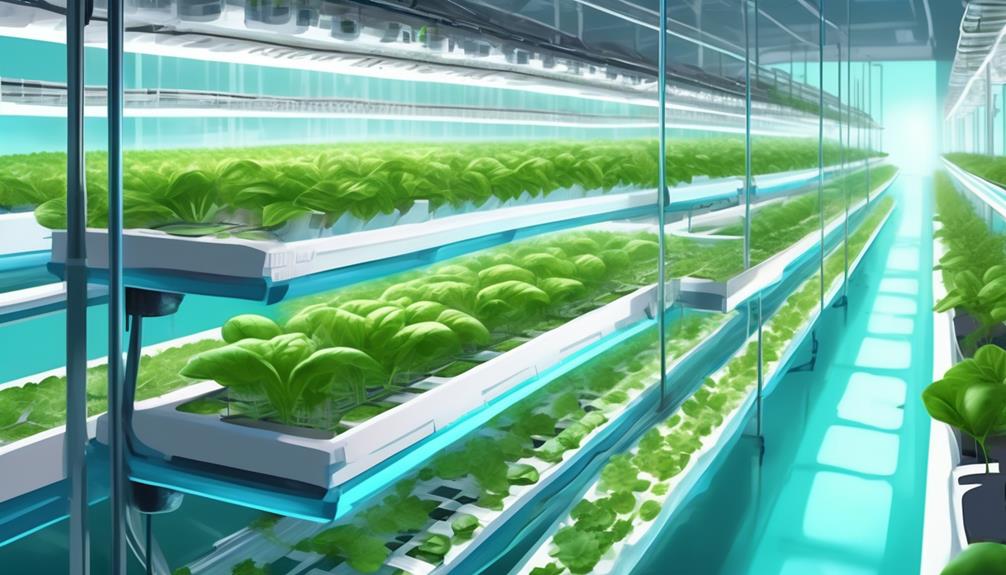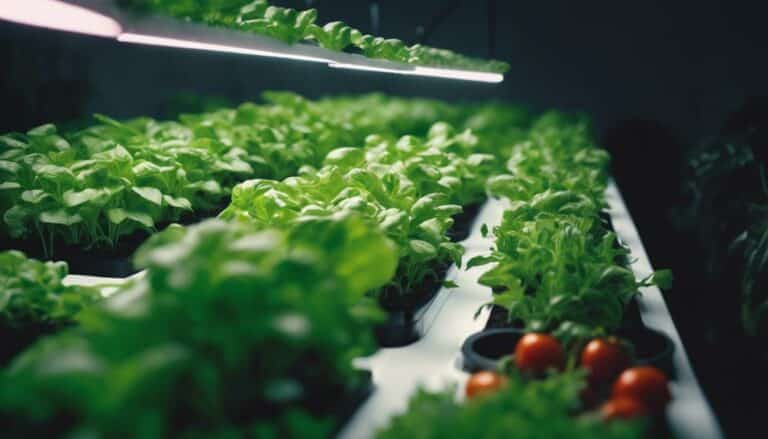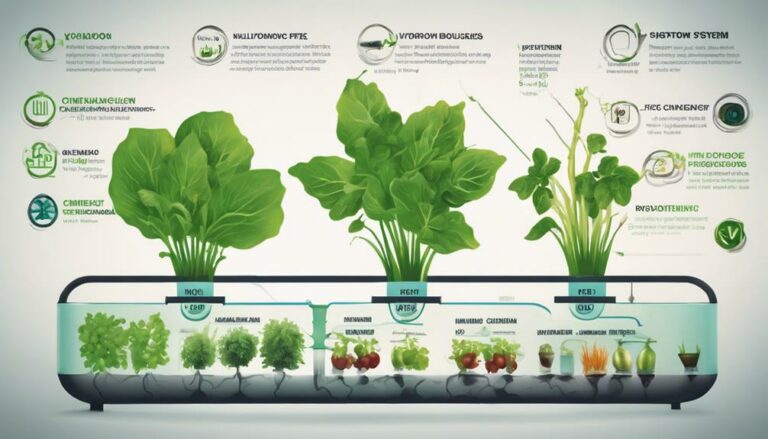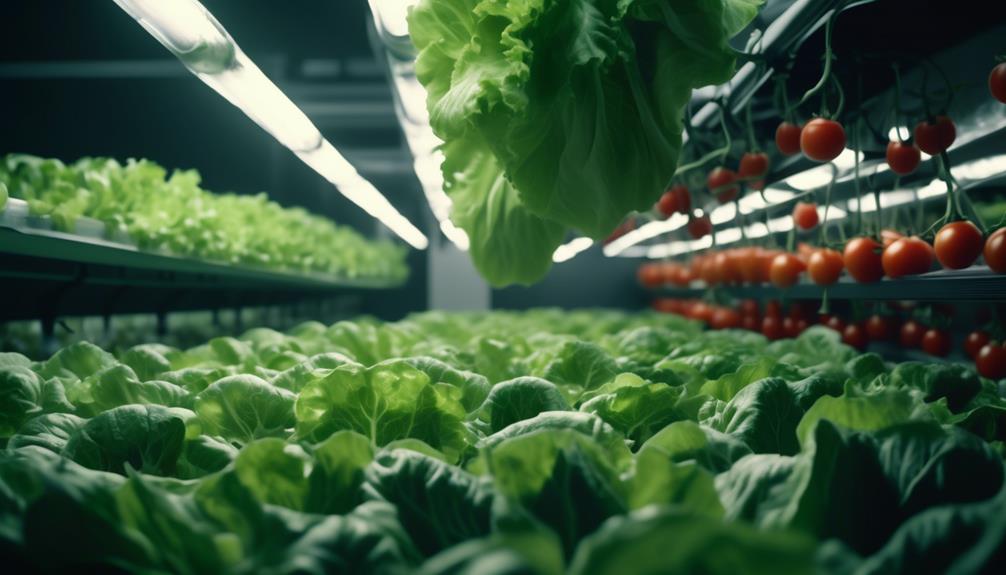In the realm of sustainable agriculture, vertical hydroponic systems are emerging as a highly efficient method of maximizing yield within limited spaces. This tutorial endeavors to guide you through the meticulous process of constructing such a system, beginning with an assessment of spatial constraints and available resources, moving towards the careful selection of an appropriate design tailored to your specific needs.
Table of Contents
As we progress, each step will be delineated with precision: from the acquisition of materials—encompassing PVC pipes, net pots, and other essentials—to the methodical construction of the vertical structure, and the integration of critical hydroponic components.
The intricacies of introducing plants and nutrient solutions will be discussed, as well as the ongoing maintenance required to ensure a thriving, productive garden. As we embark on this journey, it is essential to understand that the success of a vertical hydroponic system hinges not only on the initial setup but also on the continuous monitoring and fine-tuning of the environment in which your plants will grow.
Join us as we explore the nuances of this innovative approach to modern gardening, and uncover the potential benefits that may be reaped from such a venture.
Key Takeaways
- Assess the available space dimensions and resources before designing a vertical hydroponic system.
- Choose the right system design based on the types of crops to be cultivated and the available space.
- Consider the complexity, water efficiency, and long-term viability of the hydroponic model.
- Maximize space efficiency, optimize plant density, and plan for system expansion or reconfiguration.
Assessing Space and Resources
Before embarking on the construction of a vertical hydroponic system, it is crucial to meticulously evaluate the available space and resources, ensuring that factors such as area dimensions, material requirements, power, and water accessibility, as well as sunlight exposure, are thoroughly considered for optimal system performance and maintenance.
When assessing space for a vertical hydroponic system, innovative pioneers must consider the specific area, such as a balcony or rooftop, to ensure efficient use of available dimensions. This strategic planning will accommodate the vertical orientation of hydroponics, which maximizes plant growth vertically and minimizes the horizontal footprint.
The materials list should include PVC pipes, net pots, and a substantial 45-gallon tank to hold the nutrient solution integral to plant nourishment. A submersible pump and light timer are also essential components that facilitate the control of water level and light exposure, ensuring the system operates with precision and consistency.
Proximity to a reliable power source and an easily accessible water supply is vital for the seamless operation of the hydroponic tower. Additionally, ensuring adequate sunlight or supplementing with artificial light sources will support photosynthesis, crucial for plant health.
The design must also incorporate a plan for regular maintenance, allowing for the monitoring of nutrient levels and pH, as well as establishing cleaning protocols to maintain a hygienic environment for plant cultivation.
Choosing the Right System Design
Selecting an appropriate system design is paramount to the success of a vertical hydroponic garden, necessitating a thorough analysis of spatial constraints and yield objectives.
When choosing between a commercial tower garden or a custom-built model, one must evaluate the types of crops intended for cultivation, as these influence the structural requirements and overall efficiency of the system.
An emphasis on space optimization can guide the decision-making process, ensuring that the hydroponic model selected maximizes production within the available area.
System Design Considerations
When designing a vertical hydroponic system, it is crucial to consider factors such as spatial efficiency, crop compatibility, and resource availability to ensure a high-density yield within limited urban spaces.
Opt for a tower garden design, which maximizes space by allowing for a high plant density, accommodating up to 56 plants in just a 5×5-foot area.
Assess whether a pre-fabricated tower garden or a custom-built DIY version better suits your technical skills and budget constraints.
Select appropriate materials, like a white vinyl fence post and 3-inch PVC pipe, for structural integrity and ease of maintenance.
Incorporate a reliable submersible pump and light timer to automate the watering and lighting cycles, reducing the need for manual intervention.
Utilize white vinyl blind stop molding to secure plant cups in place, ensuring stability with much less material waste.
Hydroponic Model Selection
Having established the fundamental considerations for system design, it is imperative to meticulously evaluate the various hydroponic models to identify the one that aligns optimally with your specific agricultural objectives and spatial constraints. Vertical farming benefits such as enhanced water efficiency and space utilization must be balanced against hydroponic system cost and the intricacies of hydroponic vs soil gardening. Methodical selection is pivotal.
| Factor | Consideration |
|---|---|
| Crop Type | Determines system complexity; some models are better for leafy greens, others for fruiting plants. |
| Space Available | Vertical systems maximize limited areas, crucial for urban settings. |
| Water Efficiency | Closed-loop systems can conserve water, a key advantage over soil gardening. |
| Operational Costs | Includes energy, nutrients, and maintenance; impacts long-term viability. |
Choose a model that not only fits your operational aspirations but also promises a sustainable and innovative future in agriculture.
Space Efficiency Analysis
Analyzing space efficiency is crucial for determining the most suitable vertical hydroponic system design, ensuring optimal yield within the constraints of the available area. A meticulous approach to evaluating how the design utilizes space can significantly enhance productivity.
- Evaluate various system designs for maximizing vertical space to ascertain how well they accommodate plant growth upwards rather than outwards.
- Determine the system’s capacity for optimizing plant density without compromising the health and accessibility of each plant.
- Assess the design for efficient water and nutrient distribution, ensuring all plants receive the necessary resources.
- Consider ease of system expansion or reconfiguration to maintain space efficiency as your operation grows.
- Factor in maintenance accessibility to ensure that space-saving measures do not impede essential system care and management.
Gathering Necessary Materials
To embark on constructing a vertical hydroponic system, one must first accumulate all the essential materials, including a white vinyl fence post, pyramid post tops, a sizable tank, and other specific components as outlined.
Careful planning is crucial, with evaluating costs being a preliminary step to ensure the project remains economically feasible. Given the complexity of hydroponic systems, it is advisable to anticipate and strategize for troubleshooting common issues. Additionally, consider the potential for expanding the system capacity in the future, which would necessitate scalable material procurement.
The core structure requires a white vinyl fence post, cut to the desired tower height, and white vinyl pyramid post tops. The latter are prepared by drilling holes for nutrient distribution. A 45-gallon tank will serve as a reservoir. A plastic sheet is cut for the base, with a passage for the post. Three-inch PVC pipes are essential for the tower’s internal net pot holders, affixed with PVC epoxy for stability. The submersible pump, along with a light timer, automates the nutrient delivery and lighting cycles. Lastly, white vinyl blind stop molding is installed inside the tower to facilitate the even distribution of nutrients to the plants.
Constructing the Vertical Structure
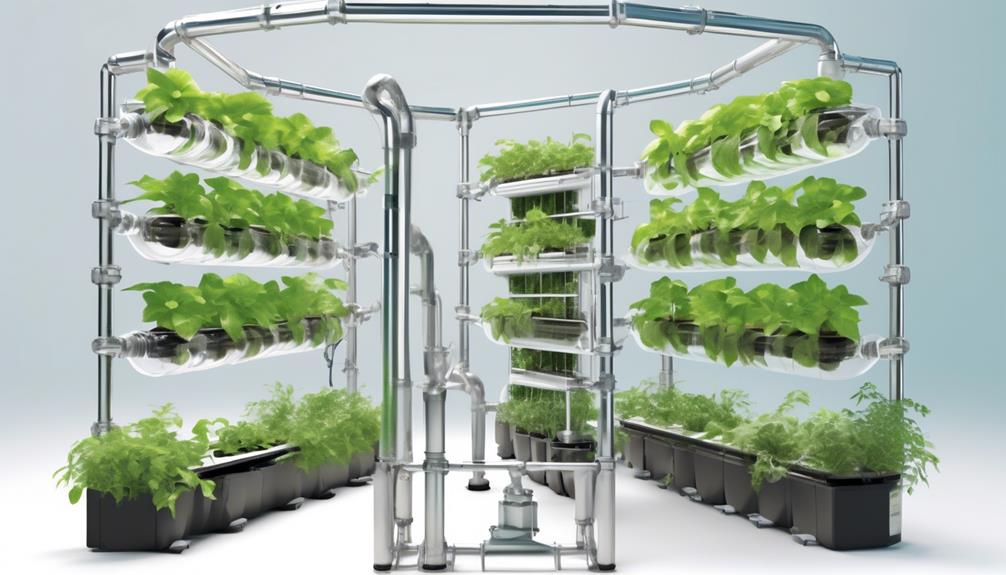
The construction of a vertical hydroponic system commences with the precise cutting of the white vinyl fence post to the specified tower height. This foundational step ensures the vertical tower’s structural integrity and suitability for crop cultivation.
Following that, a series of methodical actions enable the transformation of these materials into a functional hydroponic system.
- Cut the white vinyl fence post to your vertical tower’s desired height, maintaining a straight edge for stability.
- Using a drill, create holes in the plastic sheeting, which will act as a support layer for the fence post, and cut out spaces for net pot holders with a jig saw for plant insertion.
- Secure net pot holders inside the vertical structure with PVC epoxy to ensure they stay in place and can support the weight of the plants and nutrient solution.
- For nutrient distribution, install white vinyl blind stop molding inside the tower and ensure the net pots are firmly attached by melting the edges of the pot holes.
- Modify one pyramid post top by drilling holes for nutrient distribution and attach both pyramid post tops to the tower with hinges, allowing for easy maintenance and system checks.
These steps form the backbone of erecting a robust and efficient vertical hydroponic structure, designed for optimizing space and fostering plant growth.
Installing the Hydroponic Components
Having established the vertical tower’s framework, the next critical phase involves the installation of essential hydroponic components to ensure optimal nutrient delivery and plant support. Precision is paramount during the PVC pipe installation, which forms the backbone of the tower assembly. The white vinyl fence post should be meticulously cut to the predetermined height, ensuring uniformity across the system.
Following the cutting, the tower’s structure is further refined by drilling holes in the plastic sheet, allowing for seamless integration of the fence post. This step requires a methodical approach to maintain alignment and stability. The net pot holes are then marked and carved out with a jig saw, a process that demands attention to detail to accommodate the net pots accurately.
Net pot attachment is achieved by affixing net pot holders inside the tower. The use of PVC epoxy is critical here, providing a robust bond that ensures the longevity and reliability of the system. To facilitate nutrient distribution, white vinyl blind stop molding is installed within the interior of the tower. This component is essential for the even dispersal of nutrients, vital for plant growth and system efficiency.
Each step in the installation process is executed with precision, contributing to a robust and innovative vertical hydroponic system.
Adding Plants and Nutrient Solutions
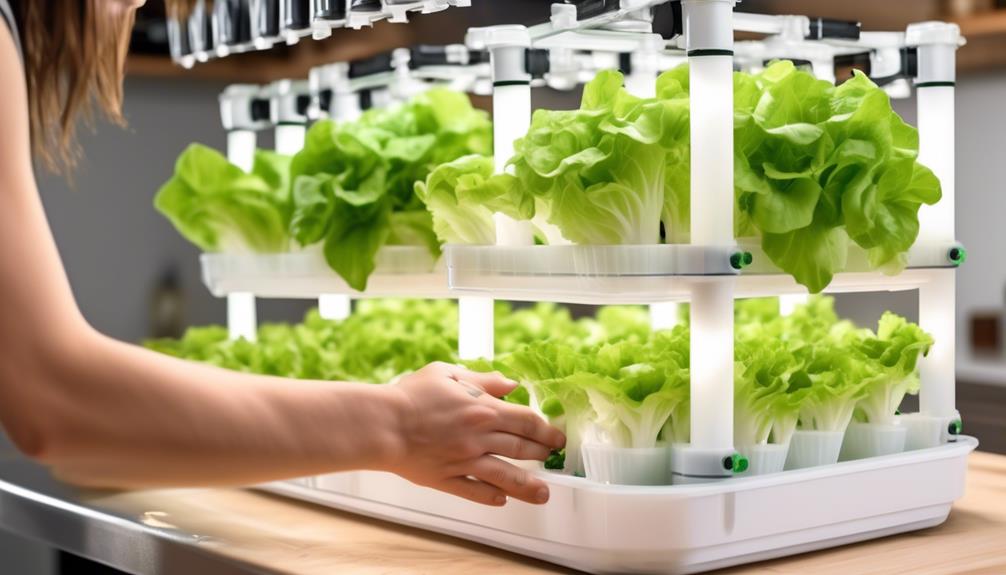
Upon completing the installation of the hydroponic system’s structural components, attention shifts to selecting and integrating suitable plants into the net pots, complemented by the careful preparation and application of a balanced nutrient solution. Choosing suitable plants is crucial as not all species thrive in a hydroponic environment. Preference should be given to those known for their compatibility with water-based cultivation.
- Choosing suitable plants: Select species that are known to perform well in a hydroponic setting, such as leafy greens, herbs, and certain vegetables.
- Nutrient solution preparation: Accurately mix water with hydroponic nutrients following manufacturer’s guidelines to ensure plants receive essential minerals and elements.
- Monitoring plant growth: Observe the development of plants regularly to detect any nutritional deficiencies or growth issues early on.
- pH level maintenance: Use pH meters and adjusters to maintain the nutrient solution within the ideal range for optimal plant health and nutrient uptake.
- System cleanliness: Perform routine inspections and cleaning to prevent clogging and ensure the entire system remains free from pathogens.
Innovative growers must be methodical in their approach, ensuring that the nutrient solution is not only well-prepared but also dynamically adjusted as plants grow and their nutritional requirements evolve. This meticulous attention to detail promises a thriving vertical hydroponic garden.
How Can I Incorporate Automated Nutrient Control into My Vertical Hydroponic System?
Incorporating automated nutrient control for hydroponics into your vertical system is crucial for maintaining optimal plant health. By utilizing sensors and controllers, you can precisely monitor and adjust nutrient levels, ensuring your plants receive the perfect balance of essential elements for optimal growth and yield.
System Maintenance and Monitoring
To ensure the longevity and productivity of a vertical hydroponic system, a rigorous approach to system maintenance and monitoring is indispensable.
A structured routine cleaning schedule is critical for preventing the accumulation of pathogens and ensuring the unobstructed flow of nutrient solutions.
Concurrently, diligent nutrient solution management, including precise adjustments of both concentration and pH levels, is essential for sustaining optimal plant health and growth.
Routine Cleaning Schedule
A consistent cleaning regimen is essential for the longevity and efficiency of a vertical hydroponic system. This regimen necessitates regular disinfection and maintenance to prevent the accumulation of harmful algae and pathogens. Employing innovative cleaning techniques is crucial for preventing algae growth and ensuring pathogen control. These factors directly impact plant health and system productivity.
- Set a regular cleaning schedule: Weekly or bi-weekly, depending on system size and plant types.
- Use safe disinfectants: Opt for non-toxic options that effectively eliminate algae and pathogens without harming plants.
- Monitor nutrient solutions: Regularly check and adjust the nutrient concentration for optimal growth conditions.
- Maintain pH balance: Test and adjust the pH levels to prevent nutrient lockout and support plant health.
- Inspect for obstructions: Check for and clear any clogs to ensure unimpeded water flow and nutrient delivery.
Nutrient Solution Management
Effective nutrient solution management is a cornerstone of successful vertical hydroponic gardening, requiring diligent monitoring and adjustment to maintain the precise balance necessary for optimal plant growth. Regular nutrient solution testing is integral to this process, providing essential information on the concentration levels of vital minerals and compounds.
Maintaining the correct nutrient solution pH levels is equally critical, ensuring nutrient availability and absorption by the plant roots. Innovators in the field emphasize the importance of periodic nutrient solution adjustment to counteract fluctuations that can occur due to plant uptake or water evaporation.
A methodical approach to system maintenance and monitoring, including careful inspection for any distribution blockages and strategic plant pruning, underpins a thriving vertical hydroponic ecosystem.
Frequently Asked Questions
How Do You Make a Hydroponic System Step by Step?
To create a hydroponic system, one must methodically integrate plant nutrition delivery, automate water and nutrient cycles, and implement precise growth monitoring for innovative, high-yield cultivation. Detailed planning and execution are essential.
What Is the Easiest Hydroponic System for Beginners?
Ironically, the simplest hydroponic system eludes many beginners. When comparing systems, the wick system stands out for its ease, utilizing basic growth mediums and nutrient solutions without the need for complex equipment or maintenance.
How Do I Start Hydroponics for Beginners?
To start hydroponics, ensure optimal water quality, utilize efficient grow lights, and precisely mix nutrient solutions. Embrace innovative methods for sustainable growth and focus on meticulous system management for thriving plant development.
How Do You Make Vertical Farming?
Vertical farming integrates growth lighting, nutrient solutions, and strategic plant selection to optimize space and yield. It requires methodical planning and innovative approaches to ensure sustainable and efficient plant cultivation in controlled environments.
Conclusion
In conclusion, the cultivation of plants within a vertical hydroponic system represents a pinnacle of agricultural ingenuity, marrying space efficiency with resource conservation.
By adhering to the steps provided, cultivators can erect a veritable garden tower that not only defies traditional farming constraints but also promises a bountiful harvest.
Diligent maintenance and vigilant monitoring ensure the system’s longevity, transforming the art of gardening into a streamlined symphony of sustainable growth.

